Analysis of the 2001-02 Budget BillLegislative Analyst's Office
|
| How Can the State Better Prepare Students for College? |
| Summary
According to university officials, approximately one-third of freshmen at the University of California (UC) and more than two-thirds of freshmen at the California State University (CSU) arrive "unprepared" for college-level reading, writing, or mathematics. Assessing Better. Many students who fail college placement exams typically spend a portion of their first year of college completing precollegiate courses. We recommend UC, CSU, and Calfornia Community Colleges (CCC): Work with high schools to develop methods to diagnose earlier whether students are ready for college-level studies. Consider aligning skills assessments with existing exams. Ensuring Progress. The UC, CSU, and CCC do not assess whether students who must take precollegiate courses actually obtain the necessary skills to succeed in college. They also do not measure the effectiveness of services employed to help students overcome their skill deficiencies. We recommend UC, CSU, and CCC assess and report on the level of preparedness of all entering students and the effectiveness of programs to help them prepare for college-level studies. Funding Precollegiate Education. Currently, the state provides UC, CSU, and CCC with very different levels of support for their precollegiate courses. We recommend the state fund precollegiate courses consistently across the segments. |
The Master Plan for Higher Education envisioned a California university system that would be renowned for providing high-quality education to the most academically distinguished high school graduates in the state. The Master Plan entrusted the community colleges with providing courses for students who were not yet prepared for college-level courses as well as lower-division college courses. The Master Plan states:
"The quality of an institution and that of a system of higher education are determined to a considerable extent by the abilities of those it admits and retains as students. This applies to all levels—lower division, upper division, and graduate. It is also true for all segments, but the emphases are different. The junior colleges are required by law to accept all high school graduates; therefore the junior colleges must protect their quality by applying retention standards rigid enough to guarantee that taxpayers' money is not wasted on individuals who lack capacity or the will to succeed in their studies. If the state colleges and the University have real differentiation of functions between them, they should have substantially different admission requirements. Both should be exacting (in contrast to public higher educational institutions in most other states) because the junior colleges relieve them of the burden of doing remedial work. Both have a heavy obligation to the state to restrict the privilege of entering and remaining to those who are well above average in the college-age group."
Many Students Arrive Unprepared for College-Level Courses. Today, both the University of California (UC ) and the California State University (CSU) admit students who are not yet ready to enroll in college-level reading, writing, and mathematics courses. The CSU estimates that more than two-thirds of its first-time freshmen require remedial courses in writing or mathematics. The UC estimates that approximately one-third of its freshmen require remedial courses in writing. (The UC does not require students to demonstrate preparedness for college-level mathematics.)
Legislative Interest in "Remedial" Education at CSU and UC. The Legislature has expressed much interest in the issue of remedial education. Specifically, the Legislature has requested information regarding the proportion of unprepared students in college, the services colleges offer to help better prepare students for college-level work, and the cost the state incurs to provide remedial education to unprepared students on university campuses. To address these issues, this report:
In this report we frequently use the terms "prepared" and "unprepared" to describe the skill level of college applicants and students. In doing so, we are borrowing from the terminology often used by administrators and faculty within CSU and UC.
Students can demonstrate they are prepared in one of three ways (see Figure 1). First, students can demonstrate preparedness by scoring above a minimum level on the SAT, American College Testing Assessment (ACT), or Advanced Placement (AP) exams. All UC applicants take the SAT I and SAT II exams, and most CSU applicants take the SAT I exam. Approximately one-third of UC and CSU regularly admitted freshmen demonstrate proficiency in this manner. (Most of these national tests are taken in students' junior and senior years in high school.) Approximately 10 percent of specially admitted UC freshmen do so. (Specially admitted students have not completed all college preparatory courses, obtained minimum grade point average (GPA) standards, and/or taken all necessary entrance exams.) The CSU could not provide data on how specially admitted students perform on these tests.
| Figure 1 | |||
| Standards for Demonstrating College Preparedness | |||
| Reading and Writing | Math | ||
| CCC | |||
| None | None | ||
| CSU | |||
|
|
||
|
|
||
|
|
||
| UC | |||
|
None | ||
|
|||
|
|||
Second, students who do not score sufficiently high on the standardized exams can demonstrate they are prepared by performing satisfactorily on placement tests developed and administered by the universities. The UC administers its placement exam—the Universitywide Subject A Examination—the first Saturday in May each year, whereas CSU offers its placement exams—the English Placement Test (EPT) and the Entry-Level Mathematics (ELM) test—several times throughout the year.
Finally, students who do not score sufficiently high on college admissions or placement exams must enroll in a precollegiate course. Typically, students take these courses on campus in their first year of college. These students demonstrate proficiency by passing the precollegiate course with either a credit (CR) grade or a D- or better.
The segments do not use the same standard for defining unpreparedness. As a result, students UC defines as unprepared in reading and writing (because they fail the Subject A exam) might be considered prepared by CSU standards (because they pass the EPT). Similarly, students CSU defines as unprepared in reading, writing, or mathematics might be considered prepared by a community college.
Based on the segments' standards, available data suggest many students entering California's public colleges and universities do not have the requisite skills to engage in college-level work. Below, we track unpreparedness rates at CSU and UC over the last decade. We do not track unpreparedness rates at the community colleges because they do not require students to take admissions tests (such as the SAT) or placement tests (such as the EPT). Consequently, the community colleges could not provide data on their students' level of preparedness for college-level studies.
As described earlier, CSU requires all first-time freshmen to demonstrate readiness for college-level reading, writing, and mathematics.
Almost Half of Regularly Admitted CSU Students Arrive Unprepared in Reading and Writing. Figure 2 shows the unpreparedness rate in reading and writing for regularly admitted freshmen over the last decade. In fall 1989, 38 percent of regularly admitted freshmen were unprepared for college-level reading and writing. By fall 2000, the unpreparedness rate had increased by more than a fifth—to 46 percent of regularly admitted freshmen. In recent years, many students have not passed the EPT because they have been unable to complete the reading portion of the exam successfully. Of regularly admitted freshmen taking the EPT in June 1997, 78 percent failed the reading component of the exam. (The combined reading and writing failure rate is lower because students can score sufficiently high in the writing section to pass the exam even if they fail the reading section.)
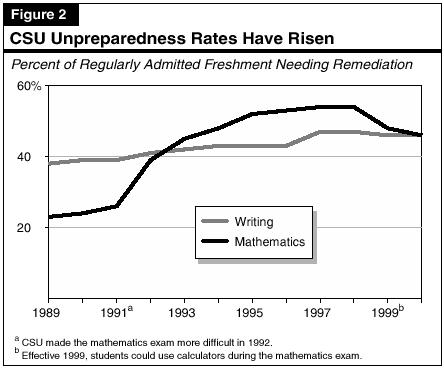
Almost Half of Regularly Admitted CSU Students Arrive Unprepared in Mathematics. Figure 2 also shows the unpreparedness rate in mathematics for regularly admitted freshmen. In fall 1989, 23 percent of regularly admitted freshmen were unprepared for college-level work. In 1992, CSU increased its admission standards to require three years of college preparatory mathematics. To reflect this change, CSU made the ELM more difficult by including questions on data interpretation, counting, probability, and statistics. Likely as a result of these changes, the number of regularly admitted students needing remedial classes in mathematics jumped from 26 percent in fall 1991 to almost 40 percent in fall 1992. From 1992 to 1998, the unpreparedness rate continued to climb, reaching 54 percent in fall 1998. The rate of unpreparedness fell in 1999 to 48 percent of entering freshmen (when the CSU allowed students for the first time to use calculators while taking the test). In fall 2000, the rate dropped further to 45 percent.
In total, more than two-thirds of regularly admitted first-time freshmen failed at least one of CSU's entry-level placement tests. Approximately one-third of regularly admitted first-time freshmen failed both placement tests.
Unpreparedness Rates Vary Considerably Across CSU Campuses. Figure 3 shows for each CSU campus the percentage of regularly admitted first-time freshmen that failed to demonstrate proficiency in writing and/or mathematics. At CSU Dominguez Hills and CSU Los Angeles—the campuses with the highest proportions of unprepared students—more than 90 percent of regularly admitted first-time freshmen were unprepared for college-level work. By comparison, approximately 25 percent of regularly admitted first-time freshmen at CSU San Luis Obispo were unprepared for college-level work.
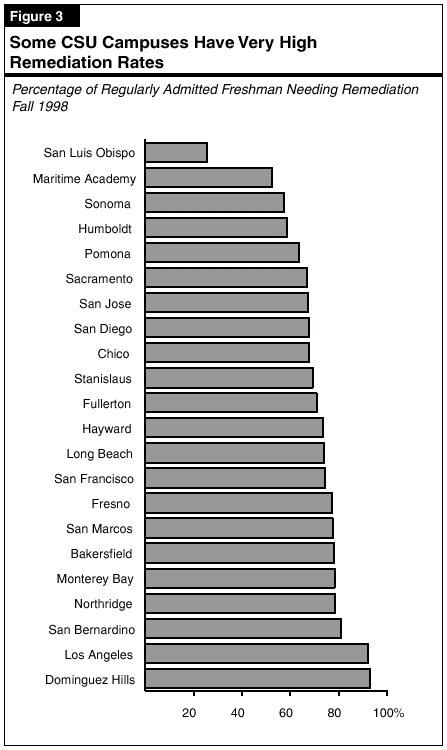
Almost All Specially Admitted Students Arrive Unprepared for College-Level Courses. A significant percentage of new freshmen at CSU do not meet the university's minimum admission standards. In 1999-00, for example, CSU admitted a total of 9.2 percent of first-time freshmen "by exception." The CSU does not record the proportion of these specially admitted students who are unprepared for college-level studies, but it indicates almost all specially admitted students are unprepared. Data provided by CSU Sacramento support this assertion. In fall 1998, 17 percent of first-time freshmen entering CSU Sacramento did not meet the regular admission criteria. Of these students, 91 percent were unprepared for college-level writing or mathematics.
Whereas CSU tests for proficiency in mathematics and writing, UC tests for proficiency only in writing. The UC calls its writing proficiency standard the "Subject A" requirement. Students can satisfy the Subject A requirement either by exceeding a minimum score on the SAT I, SAT II, ACT, or AP tests or by passing the university's Subject A writing test. Students who do not demonstrate proficiency must enroll in a remedial writing class.
More Than One-Third of UC Students Arrive Unprepared for College-Level Writing. Figure 4 shows the percentage of UC students that did not satisfy the Subject A requirement from fall 1988 to fall 1999. In fall 1988, 35 percent of regular admits and 74 percent of special admits were unprepared for college-level writing. By 1999, these percentages had changed only slightly—to 32 percent and 73 percent, respectively. (During these years, the university specially admitted approximately 5.5 percent of freshmen.)
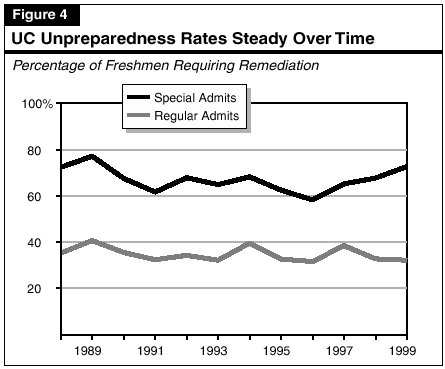
Considerable Variation Exists Among UC Campuses. Figure 5 shows the percent of entering students that did not meet the Subject A requirement at each UC campus in fall 1999. (The San Francisco campus is not included because it serves only postbaccalaureate students in health sciences.) At UC Berkeley, only 17 percent of regularly admitted freshmen did not satisfy the Subject A requirement. By comparison, 60 percent of regularly admitted freshmen did not satisfy the Subject A requirement at UC Riverside. At all campuses, the unpreparedness rates for special admits are substantially higher than the rates for regular admits. In fall 1999, the unpreparedness rates for special admits ranged from a low of 57 percent at UC Santa Barbara to a high of 100 percent at UC San Diego (though it specially admitted only four students).

The college administrators and faculty we interviewed all agreed that students' preparation for college-level studies is a key determinant of their prospects for success in college. They said students benefit significantly from comprehensive assessments of their skills. They also emphasized the importance of assessing all prospective students and assessing them as early and regularly as possible. In this section, we identify options for improving the segments' assessment process. We then examine the services the segments provide to unprepared students and identify options for improving the segments' level of accountability to students and the state.
We recommend the community colleges, CSU, and UC work with high schools to develop methods to diagnose readiness for college-level work while students are in high school.
Students who do not score sufficiently high on college entrance exams do not know whether they will be able to enroll directly in college-level courses until after they have been admitted to UC or CSU. Only after these students have been admitted and have taken the requisite entry-level tests do they know whether they must take remedial writing or math classes. Similarly, students entering community colleges often do not know they are unprepared for college-level studies unless they take placement exams or until they actually enroll in a college-level course. Consequently, the current process poorly serves students both because it informs them of their skill deficiencies only after they have been admitted to college and because students then must pay relatively high fees to enroll in remedial classes. Given these serious disadvantages, we recommend the segments work closely with high schools to ensure students are advised as early and as frequently as possible about their preparedness for college-level studies.
Early Diagnoses Could Save Students Time and Money. Currently, almost all students who fail UC's and CSU's placement exams enroll in precollegiate writing and/or mathematics courses during the first (and sometimes second) year of college. Students taking precollegiate courses do not receive credits toward their college degree. Consequently, students taking precollegiate courses in college tend to require more time and more resources to obtain their college degrees.
In addition to prolonging students' time to degree, both CSU and UC charge the same fees for precollegiate courses—such as reading and vocabulary development, basic writing, and basic algebra—that they charge for all other undergraduate courses. Full-time students pay approximately $60 and $130 per semester unit at CSU and UC, respectively. If students knew they needed to improve their basic skills to be prepared for college-level work, students might prefer to take or retake courses at no charge while they are still in high school. They could also take the necessary precollegiate courses at community colleges, which charge only $11 per unit (or $33 for a typical 3-unit course).
The UC's and CSU's Recent Efforts to Assess Students Earlier. In an effort to provide aspiring college students, parents, and high school teachers with earlier warnings of skill deficiencies, UC and CSU recently instituted two noteworthy programs—both of which demonstrate how UC, CSU, and the community colleges might alter their current assessment to better serve students. First, UC and CSU began piloting the Diagnostic Writing Service (DWS) in 1999. The DWS is a web-based tool that 11th grade students may access to obtain feedback on their writing skills. Students respond to questions from previously administered EPT and Subject A exams, and university faculty assess their essays.
The UC and CSU also are expanding their Mathematics Diagnostic Testing Project (MDTP) to allow high school students to take math diagnostic tests. (Previously, UC and CSU administered the diagnostic tests only to college students.) Now, high school students can take diagnostic exams before and after each college preparatory math course. Although scores on these exams satisfy college proficiency requirements only when taken in college, the exams do provide students with an opportunity to identify and remedy their skill deficiencies prior to enrolling in college.
Segments Should Consider Aligning Skills Assessments With Existing High School Exams or University-Approved Exams. Although UC and CSU have made efforts to inform students of their skill deficiencies while still in high school, they might also seek to base their assessments on existing high school exams. High school students are tested from among several standardized tests, including the:
Given the breadth of high school testing, students could use high school test results to diagnose their level of preparedness for college. If the universities, however, prefer different tests, then the segments could work with high schools to develop university-approved writing and mathematics tests that schools could administer following college preparatory writing and math courses.
Once students have been assessed and deemed unprepared, the community colleges, CSU, and UC employ a variety of strategies to help them overcome their skill deficiencies and succeed in college-level courses. In this section, we identify the precollegiate services each segment offers. In the remaining sections, we highlight options for improving precollegiate education.
The community colleges offer collegiate, vocational, and recreational courses. In addition to these courses, they offer both noncredit and credit precollegiate courses. Noncredit precollegiate courses primarily serve students who have not yet graduated from high school and adults who have special educational needs. Noncredit courses also include some English as a Second Language (ESL) courses, high school equivalency exam (GED) courses, and elementary and secondary education courses.
In contrast, precollegiate courses taken for credit primarily serve students aspiring to progress into transferable college courses. These precollegiate classes are designed for students who are somewhat better prepared than students enrolled in noncredit precollegiate courses. Thus, the primary differences between noncredit and credit precollegiate courses are the students' entering levels of proficiency and the students' basic educational objectives.
Precollegiate courses at CSU do not provide credits toward a baccalaureate degree. Most of CSU's precollegiate courses are traditional, term-length classes, taught by CSU instructors. These types of courses account for a large percentage of all lower division writing and mathematics courses. In spring 1999, for example, CSU Sacramento offered 156 course sections in precollegiate writing and mathematics. By comparison, the campus offered 169 sections in all its college-level lower division writing, English, and mathematics courses combined.
Although many precollegiate courses are taught by CSU faculty, several CSU campuses arrange for community colleges to teach precollegiate courses to their students. In fall 1999, for example, community colleges taught 55 of the 142 precollegiate course sections offered at CSU San Diego.
In addition to term-length precollegiate courses, several CSU campuses have begun experimenting with alternative course formats. For example, CSU San Diego and CSU Los Angeles have begun offering special courses that allow students who score only a couple points below the passing score on the EPT to enroll in a college-level writing course on the condition they also enroll in a noncredit tutoring session. Several campuses now also offer computer-assisted and self-paced instruction. The CSU San Luis Obispo campus, for example, has replaced all traditional remedial math classes with self-paced (but instructor-assisted) computer tutorials. In addition, several campuses have begun offering short workshops. For example, CSU Los Angeles currently offers a 40-hour mathematics workshop for students who fail the ELM and have not completed their precollegiate course work by the beginning of their second year.
The CSU's Disenrollment Policy. In fall 1998, the Chancellor's Office issued Executive Order 665, which requires campuses to disenroll students who do not complete precollegiate courses in a timely fashion. Specific campus policies vary, but most campuses now require students to complete their precollegiate courses in 12 months or 15 months after initially enrolling on campus. (Variations exist because some campuses allow students to enroll in precollegiate courses during the summer before or after their first academic year without having these terms apply to the time limitations.)
As Figure 6 (see next page) shows, the percentage of students needing remedial education that did not complete it within the required time varied from a low of 7 percent at the Maritime Academy to a high of 58 percent at CSU Stanislaus. Of all CSU regularly admitted first-time freshmen in fall 1998 who needed remediation, more than 20 percent had not completed their precollegiate courses within one calendar year.
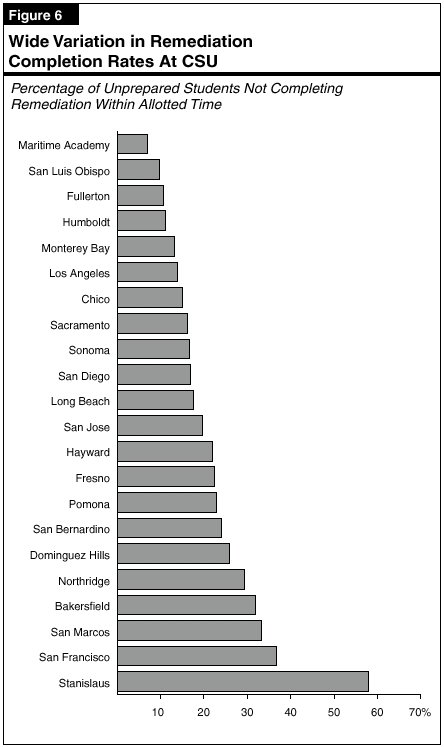
Of the students not completing precollegiate course work within the allotted time, approximately one-third were administratively disenrolled, one-third left voluntarily, and one-third were permitted to extend their precollegiate course work into their second year of college. Figure 7 shows, for each CSU campus, the percent of regularly admitted first-time freshmen entering CSU in fall 1998 who needed remediation but were allowed to enroll in fall 1999 even though they had not yet passed all requisite precollegiate courses. Despite CSU's policy—which requires campuses to disenroll students who do not meet the time requirement unless the student faced extenuating circumstances—actual campus practices vary greatly. Reenrollment rates range from zero at the Maritime Academy to 60 percent at CSU Stanislaus. No information was available regarding the remaining students who did not continue to their second year. The CSU indicated, however, that many campuses encouraged these students to enroll in community colleges.
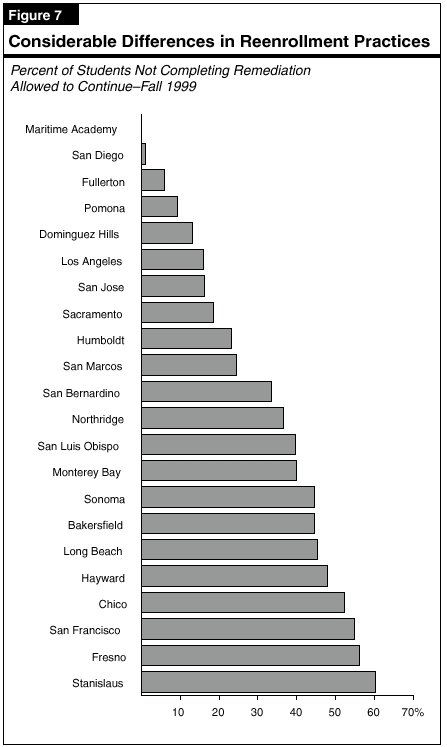
Most UC students needing remediation satisfy their Subject A writing requirement in full-term courses that do not provide credit toward a baccalaureate degree. Like CSU, UC encourages native and nonnative English speakers to enroll in different precollegiate course tracks. Whereas native speakers typically enroll in a one-term writing intensive course, nonnative speakers typically enroll in a one- to three-term language-focused and writing-focused course sequence.
Remedial Classes for Credit. Several campuses have reformatted their precollegiate courses for credit. For example, UC Berkeley now offers a six unit degree-credit course to students needing to satisfy the Subject A requirement. Faculty say they offer degree credit because the course now combines precollegiate material with more advanced, college-level material.
The UC Also Uses Community College Faculty. Both UC San Diego and UC Davis collaborate with local community colleges to provide UC students with precollegiate courses. The San Diego campus has used local community colleges to teach its precollegiate courses for more than 15 years, and UC Davis began its collaboration with Sacramento City College in 1993. Faculty we interviewed at both of these campuses praised the collaborations.
Although all public higher education segments offer precollegiate services, it is difficult to hold them accountable for providing high-quality services. Currently, neither the Legislature nor the public can easily or meaningfully evaluate how public higher education helps unprepared students obtain the skills they need to succeed academically during the remainder of their college experience. To encourage segments to serve students with high-quality, cost-effective, and prompt services, we recommend the Legislature consider the following two options. First, the Legislature should require all three segments to assess and report on the preparedness of all entering students. Second, the Legislature should require all three segments to assess and report on the effectiveness of their precollegiate services.
We recommend the Legislature require the community colleges, CSU, and UC to assess and annually report on the reading, writing, and mathematics proficiency of all entering students—including transfer students.
If the Legislature and the public are to begin holding the three segments accountable for the precollegiate services they provide, they must first obtain basic information on the nature and magnitude of entering students' unpreparedness. Once they have access to this information, they can then begin measuring the segments' ability to help these students overcome their deficiencies. Although information on the proficiency of entering students is critical to the Legislature's ability to hold all segments of public education accountable, UC is the only higher education segment that has historically assessed and reported on the preparedness of all entering students.
Community Colleges Should Assess and Annually Report on the Proficiency of All Entering Students. As noted earlier, the community colleges do not routinely or uniformly assess students for proficiency in basic reading, writing, and mathematics. Many community college faculty we interviewed, however, were discouraged by the large number of their students who lacked basic academic skills and were thus, unable to succeed in college-level courses. Campuses could better assist students in identifying which courses best meet their needs by more systematically assessing their level of academic preparedness. Equally important, campuses should report on the proportion of all entering students who are unprepared for college-level reading, writing, and mathematics, and the community college Chancellor's Office should report systemwide figures on unpreparedness.
The CSU Should Also Assess and Annually Report on the Proficiency of All Students—Including Specially Admitted Students. Unlike UC, which has reported the Subject A pass rates of all entering students—both regular and special admits—since 1978, CSU did not provide the Legislature with any systemwide information on its unprepared students until fall 1999. The CSU is now making efforts to report the EPT and ELM pass rates of regularly admitted students at each of its campuses. In its new annual accountability reports, CSU also plans to report the proportion of unprepared regularly admitted students who complete remedial coursework and reenroll one year later. Although these recent efforts are laudable, CSU still is not reporting any comparable information for its specially admitted students. Given these students are likely to be in greatest need of precollegiate services, the Legislature should require CSU to report on their entering level of proficiency.
The CSU and UC Should Assess and Annually Report on Proficiency of All Transfer Students. Whereas CSU and UC require first-time freshmen to demonstrate through testing that they are proficient in basic skills, they do not require transfer students to take comparable proficiency exams. Transfer students only need to have passed the appropriate community college courses to be able to enroll in upper division CSU and UC courses. The reason CSU and UC treat first-time freshmen and transfer students so differently is unclear. The universities say they require first-time freshmen to demonstrate proficiency by passing placement exams because the content of college preparatory courses varies considerably among high schools and high school grades mask real discrepancies in skill levels. Based upon interviews with CSU and UC faculty, the content of college transferable courses and the standards used in determining community college grades are also likely to vary substantially across campuses, making it difficult for faculty to place transfer students appropriately without more objective assessment tools. Our interviews with transfer students reinforced the faculty's claims. Transfer students also stated that their community college coursework did not always prepare them for rigorous upper division CSU and UC courses, and some students believed they were poorly served by being inappropriately placed into CSU and UC courses. Consequently, we recommend that CSU and UC work with community colleges to develop methods for assessing transfer students before they transfer and annually report on the proficiency of all transfer students.
The CSU San Diego Already Requires Transfer Students to Demonstrate Proficiency. Of all CSU and UC campuses, CSU San Diego is the only one that currently requires transfer students to demonstrate proficiency in basic skills. The San Diego campus requires transfer students to pass its Transfer Writing Proficiency exam and Transfer Mathematics Proficiency exam—both of which were developed by the campus. Transfer students who do not pass the tests receive remedial training and then must retake and pass the tests before they can enroll in upper division writing and mathematics courses. (Transfer students who have not passed the proficiency exams can nonetheless enroll in upper division courses in other subjects, just as first-time freshmen deemed unprepared can still enroll in lower division courses in other subjects.) The campus says it began this practice precisely because (1) it had difficulty in appropriately placing incoming transfer students, (2) transfer students were struggling, and (3) faculty were having difficulty maintaining the rigor of their upper division courses.
We recommend the Legislature require the community colleges, CSU, and UC to assess and routinely report on the effectiveness of their precollegiate services.
None of the three segments currently requires students to pass a standardized proficiency exam upon completion of a precollegiate course. When we asked the universities why they do not use standard exit tests to ensure students have obtained the requisite basic skills, they said students demonstrate proficiency for college-level writing and mathematics after passing one or more precollegiate classes. Not only do the segments not assess students upon the completion of remedial courses, they also do not track the future academic success of initially unprepared students. This means they cannot evaluate the merits of any of the various precollegiate services they provide.
Post-Assessment Key to Accountability. Just as the universities test high school graduates for competency in basic skills—even though the students may have received high grades in their high school writing and mathematics classes—it would make sense for universities to evaluate whether completion of precollegiate classes adequately prepares students for college-level studies. If the standardized tests CSU and UC rely on to measure a student's preparedness for college-level studies are valid, then they should also be valid indicators of whether a student has become adequately prepared after taking a precollegiate class. Such post-course assessments would signal to students, faculty, and administrators whether students do become adequately prepared for more rigorous college-level work by completing CSU or UC precollegiate courses. College administrators could also use standardized assessments to measure the relative effectiveness of different instructional strategies, thereby allowing them to enhance the quality of their services.
Tracking Future Academic Success Also Key to Accountability. Currently, the segments have very little information on the future academic performance of initially unprepared students. The segments should track and periodically report on the future academic performance of randomly selected students. The segments should identify the type of precollegiate service(s) students receive as well as students' future academic performance and retention. Periodically assessing the progress of students—both those who are initially prepared and unprepared—would provide greater assurances that the segments are meeting students' academic needs. It would also provide data that policymakers could use to evaluate campus performance and to identify the types of programs that best serve students.
State funding practices affect the segments' decisions regarding whether to admit unprepared students. These funding practices also affect how the segments provide precollegiate instruction. In this section, we examine how the state funds precollegiate courses at each of the segments and analyze how these budget practices affect CSU's and UC's incentives to serve unprepared students.
State Funds All Precollegiate Courses at the Community Colleges. The 1999-00 budget provided $1,915 in state and local funds per full-time-equivalent (FTE) student enrolled in noncredit precollegiate courses. By comparison, the 1999-00 budget provided $3,492 per FTE student enrolled in credit precollegiate courses. Additionally, as noted earlier, UC and CSU contract with some community colleges to provide precollegiate instruction. In such cases, community college faculty teach UC and CSU students on the universities' campuses. The community colleges receive state funding for enrollment in these courses (as noted above—$3,492 per FTE student in 1999-00).
State Funds Precollegiate Courses at CSU But Not at UC. Currently, the state provides CSU with the same level of funding for students enrolled in precollegiate and college-level courses. It does so even though students enrolled in precollegiate courses at CSU do not receive credit toward their baccalaureate degree. For 2000-01, the state provided CSU with $5,813 per additional FTE student.
Precollegiate courses at CSU, however, appear to be much less costly than college-level courses. Figure 8 shows, for example, that CSU Sacramento uses disproportionately more graduate students and part-time instructors for precollegiate courses than for regular lower-division courses. Given that the vast majority of precollegiate courses are taught by graduate students or part-time faculty, these courses are also likely to be comparable in cost (or might even be less costly) than community college courses.
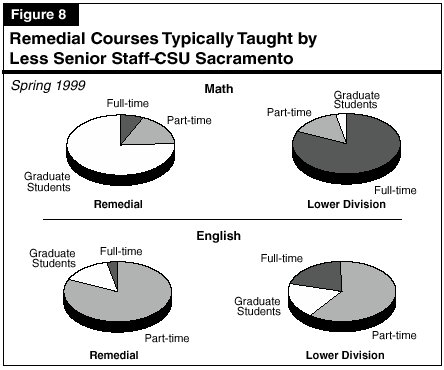
In contrast to CSU, the state does not fund precollegiate courses at UC. While the state currently provides $8,554 for each additional FTE student UC enrolls in college-level courses, it does not provide any funding for students enrolled in precollegiate courses. The UC campuses bear the costs of these courses.
Current Funding Practices Generate Perverse Incentives for Both CSU and UC. By providing CSU with the same level of funding for unprepared and prepared students (even though precollegiate courses are typically less costly than college-level courses), state policy encourages CSU to admit unprepared students—regardless of whether those students could be as well or better served at a community college. If the state funded courses for unprepared students at a rate more consistent with costs, it would reduce this incentive.
In contrast, by not providing state support for unprepared students enrolled in precollegiate courses at UC, many UC campuses allow only the most challenged students to enroll in precollegiate courses. For example, UC Riverside allows only nonnative English speakers to enroll in precollegiate writing courses. Several UC campuses also routinely mainstream students that have not yet satisfied the system's Subject A requirement, which allows The UC to obtain more state funding for remedial students. The UC Riverside, for example, encourages native English speakers who fail the Subject A exam to enroll directly in lower division courses. Because it does not characterize these courses as precollegiate, it receives full state funding for them.
We recommend the state fund CSU's and UC's precollegiate writing and mathematics courses at the same rate it funds credit courses at the community colleges.
As described in the previous section, the state currently funds precollegiate services at the three segments in widely disparate ways. The current funding system also appears to reflect poorly the actual costs the segments are incurring in providing these courses. To address these concerns, we recommend the state fund all precollegiate courses at the community college rate.
This proposed funding change would improve the incentives CSU and UC have to tailor precollegiate services to the special needs of unprepared students. Whereas CSU currently has an incentive to admit unprepared students without considering the full array of options available for serving them, this funding change would encourage CSU to reconsider the most efficient and effective way to deliver precollegiate services. Perhaps most importantly, it would provide CSU with additional incentives to expand its collaborations with community colleges.
In contrast to CSU, UC would actually obtain more funding for its precollegiate courses because the state currently does not support them. Obtaining state support would obviously make it easier for UC to offer these courses. Moreover, the proposed funding change would encourage UC to provide all unprepared students—both native and nonnative English speakers—with appropriate academic assistance.
Today, many students are arriving at public colleges in California unprepared for college-level reading, writing, and mathematics
courses. In this report we recommend a multifaceted strategy to address this problem by assessing student preparedness earlier,
improving accountability in precollegiate education, and funding precollegiate courses in a more equitable and effective manner.